L
LÆRAÐR: The tree that grows on the roof of Valhalla; the goat Heiðrún and the stag Eikþyrnir feed on its leaves. A miniature manuscript of the Snorra Edda, created by Ólafur Brynjúlfsson in the eighteenth century, depicts this scene. This tree is presumably identical to Yggdrasill.
LAND SPIRITS (Old Norse landvættir, sg. landvættr): According to ancient beliefs, the world belongs to the spirits. If someone wishes to colonize land and settle on it, the land spirits must be driven off it. This can be done, for example, by shooting a flaming arrow over the desired piece of land or by offering these spirits propitiatory sacrifices. The purpose of the grimacing figureheads on Viking ships was to disperse the spirits of the land being attacked so that victory would be won more easily. The laws of the time required that these detachable figures be removed from the prows of the ships when returning home. Land spirits gradually became conflated with elves and dwarves and were subsequently demonized by Christianity, but in folk traditions they continue to live in remote areas, cliffs, forests, and mountains. The Germanic view is hardly dissimilar from that of the ancient Romans, who said that the world was inhabited by beings called fauns, satyrs, woodland spirits, and so forth.
 Hultkrantz, ed., The Supernatural Owners of Nature; Lecouteux, Demons and Spirits of the Land.
Hultkrantz, ed., The Supernatural Owners of Nature; Lecouteux, Demons and Spirits of the Land.
LANDVÆTTR (pl. landvættir):  LAND SPIRITS
LAND SPIRITS
LANGBARÐR (“Long-beard”): A nickname for Odin that probably refers to the following legend. When the Winnili were forced to wage war with the Vandals, Gambara, mother of the chieftains Ibor and Agio, went before Frea (Frigg), the wife of Godan (Odin), and begged her to grant victory to her sons. Frea advised her as follows: the Winnili women should let their hair fall in front of their faces like beards, then accompany their husbands at dawn in a place where Godan could not help but see them when looking out his window. When he saw them, he shouted out, “Who are these long-beards?” Frea suggested he grant victory to those whom he had just given a name. The Winnili were victorious and henceforth called themselves Langobards, meaning “Long-beards.”
 Falk, Odensheiti.
Falk, Odensheiti.
LANGE WAPPER: This was a water spirit of the sixteenth century. Using trickery it would transform into a baby so it could nurse on women’s milk. It can be found in Dutch and Belgian traditions. It can appear in the form of a human being (apprentice, sailor, priest, watchman, porter, egg or chicken merchant, or old woman), an animal (cat or dog), or even an object (napkin or garment). It haunts cemeteries, churches, and houses. It plays cards and punishes thieves. It can travel from Antwerp to Mechelen in a single step; it is also said that it can fly through the air, is a magician, and only comes out at night.
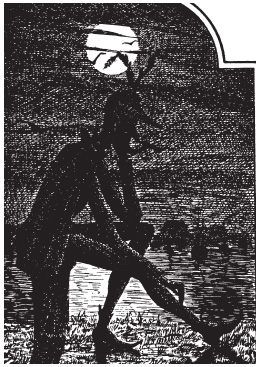
Fig. 46. Lange Wapper
Lange Wapper is also a bogeyman that parents describe to dissuade their children from going too close to the water. It has become a figure of folklore and entered into the retinue of processional giants.
 Hageland and Lamend, Lange Wapper en Kludde; E. Willekens, “Lange Wapper, een Antwerpe legendarische figuur,” Antwerpen I (1955): 119–22.
Hageland and Lamend, Lange Wapper en Kludde; E. Willekens, “Lange Wapper, een Antwerpe legendarische figuur,” Antwerpen I (1955): 119–22.
LANGTÜTTIN (“Long Breasts”): In the Passeier Valley (Val Passiria, Italy) of the southern Tyrol, this is the name of a hideous woman who runs after children offering her breast, but milk flows only from one and pus flows from the other. She is sometimes associated with a wild man.
 Zingerle, Sagen aus Tirol, 110–11.
Zingerle, Sagen aus Tirol, 110–11.
LAUFEY: Loki’s mother.
LAURIN: King of the dwarves. He lives in the Tyrol Mountains, where he owns a wonderful rose garden that is vandalized by Dietrich von Bern (the epic and legendary transposition of Theodoric the Great) and his companions Dietleib and Witege. Defeated by Dietrich, Laurin is only spared due to the intervention of Dietlieb—whose sister (named Kunhilt or Sinhilt) he had abducted—and he invites the knights to visit his hollow mountain. He then gives them a sleeping potion to drink and imprisons them in a dungeon. With the help of Kunhilt they are able to overturn their situation, and they go to Ravenna with Laurin, where he is then instructed in the Christian faith.
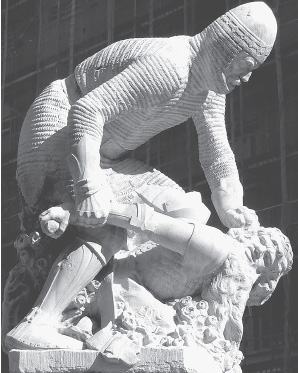
Fig. 47. Dietrich von Bern’s battle with the dwarf king Laurin
Laurin measures three spans (just over two feet), and his horse is the size of a roebuck. The dwarf owns a magic ring and belt, both of which give the wearer the strength of twelve men; he also possesses the cloak of invisibility (Tarnkappe). He is the nephew of Walberan, who rules over the dwarves that live between Judea and the Caucasus.
In another text, the Wartburgkrieg (Wartburg Contest), it is said that Laurin is the father of Sinnels, another dwarf king. Dietrich allegedly followed Sinnels and was never to be seen again, which is reminiscent of the legend of King Herla.
 Lecouteux, Les Nains et les Elfes au Moyen Âge.
Lecouteux, Les Nains et les Elfes au Moyen Âge.
LAUTERFRESSER: A Tyrolean spirit capable of assuming many shapes. It could take on the appearance of a fly, a mosquito, and sometimes that of a bear. In the form of a vagabond it caused rain to fall by throwing into the water the needles used to sew a shroud, hairs from a woman’s head, sweepings, and stones. It owned a magic tube made from the shaft of a white goose feather in which were placed seeds from a fern harvested beneath the light of a comet, a mortuary needle, and the tongue of a white worm. When the spirit blew inside it, it would snow. The Lauterfresser knew how to make itself invisible and invulnerable, possessed superhuman strength, which it drew from Satan, and could provoke rats, mice, and horses as it knew their language. It cannot tolerate children and will make them disappear.
Originally this spirit was a historical figure, Mathias Perger (ca. 1587–1645), who was executed after being accused of witchcraft. He allegedly took part in a Sabbat where the devil, Belial, gave him a bearskin that allowed him to change his shape, and so forth. Aspects of his trial provided the basis for his legend and for his transformation into a mythical figure.
 Heyl, Volkssagen, Meinungen und Bräuche aus Tirol, 229.
Heyl, Volkssagen, Meinungen und Bräuche aus Tirol, 229.
LECKFRÄULEIN (pl.): Name given to the good fairies of the Italian Tyrol ( SALINGEN). They live in caves. When they visit a farm they bring good fortune, but when a farmwife refused them food one day, the prosperity of the place vanished.
SALINGEN). They live in caves. When they visit a farm they bring good fortune, but when a farmwife refused them food one day, the prosperity of the place vanished.
 Heyl, Volkssagen, Meinungen und Bräuche aus Tirol, 276.
Heyl, Volkssagen, Meinungen und Bräuche aus Tirol, 276.
LENORE: The title and heroine of a famous ballad by Gottfried August Bürger (1747–1794), published in 1774. In despair at the death of her fiancé, a young woman commits blasphemy. At midnight the one whom she believes to be dead comes for her. He carries her off on a mad ride on horseback to the cemetery where the earth opens to swallow both of them up.
Bürger was inspired by an anonymous German poem that borrowed a theme common throughout Europe, namely in the Danish ballad Aage og Else, of “the return of the deceased fiancé.” The most beautiful examples of this theme can be found in the Greek Acritic Songs and in a book titled Kytice by the Czech writer Karel Erben.
Bürger’s text enjoyed great success. Walter Scott translated it into English as William and Helen in 1796, Johann Rudolf Zumsteeg set it to music in 1798, Henri Duparc made a symphonic poem based on it in 1875, and it was the inspiration for Vasily Zhukovsky’s Ludmila. In 1839 the painter Horace Vernet depicted the dead man’s ride with his fiancée mounted behind him in a painting that is now housed in the Museum of Fine Arts in Nantes, France.
 AAGE and ELSE
AAGE and ELSE
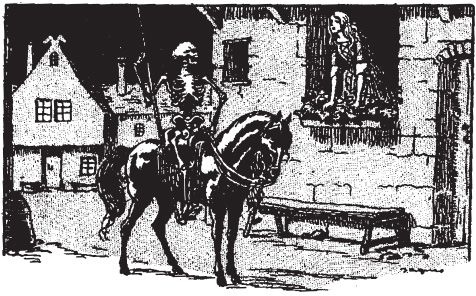
Fig. 48. The Ballad of Lenore. Illustration from a German textbook (1930).
LÍF (“Life”): One of the two survivors of Ragnarök, the other being Lífþrasir. Both are fathers to a new generation of humanity.
LÍFÞRASIR (“Striving for Life”): He and Líf survive the destruction of the Earth during Ragnarök because they find refuge in the grove called Hoddmímir (“Treasure-Mímir”), in other words, Yggdrasill, at the foot of which lies the Well of Wisdom, “Mímir’s treasure.” They feed on morning dew and engender the next race of men.
LIGHT ELVES (Old Norse ljósálfar, sg. ljósálfr): The name Snorri Sturluson gave to elves to distinguish them from dwarves, which he seems to confuse with dark elves. They inhabit the hall called Gimlé (“Shelter from the Flames”).
LIGO: God of spring and joy for the ancient Prussians. Virgins kept a fire of oaken logs permanently burning for him. He was worshipped on the summit of the Rinau (Galtgarbenberg).
 Rhesa, Prutena, 147–49.
Rhesa, Prutena, 147–49.
LINDWURM: One of the names for a dragon in the Middle Ages. The word translated the Latin term iaculus, which designates a serpent that hurls itself on its prey from the treetops; hence it should be considered to be a flying serpent. It is also a hydra.
LITR (“The Colored One”): The name of a dwarf who abruptly shows up at Baldr’s funeral. Thor dispatches him with a kick into the funeral pyre. The meaning of this odd passage is clarified when one knows that dwarves maintained close relations with the dead. Litr could be a psychopomp charged with guiding the dead man to the home of Hel, the goddess of the underworld.
LITTLE GRAY MAN (GRAUMÄNNCHEN): In central and northern Germany this is a ghost that announces a death but also a bogeyman and a guardian of treasures. He has become conflated with kobolds and dwarves.
LJÓSÁLFAR:  LIGHT ELVES
LIGHT ELVES
LÓÐURR: God mentioned in a triad together with Hœnir and Odin. Nothing is known of him except that Odin was his companion.
LŒÐING: The first of the three fetters that the gods used to bind the wolf Fenrir. He breaks it, along with the second one, Drómi. Only the third fetter, Gleipnir, holds him fast.
LOFN (“The Sweet One”): A kind Ásynja who asked Odin and Frigg for the power to bring together men and women whose marriages had been forbidden until that time.
LOGAÞORE: A sixth- or seventh-century fibula discovered in Nordendorf bears a runic inscription that has yielded the names of three gods: Logaþore, Wodan, and Wigiþonar. Attempts have been made to equate Logaþore with Lóðurr and with Loki, but none of the solutions has proved satisfactory, and this deity remains a mystery.
LOGI (“Fire”): Name of a giant who is one of the three sons of Fornjótr and, perhaps, a personification of the all-devouring fire. He is Loki’s adversary in the following tale. Thor has gone to the home of the giant Útgarðaloki in Jötunheimr, accompanied by Loki, Þjalfi, and Röskva. Útgarðaloki asks them what test they would like to take, and Loki boasts that he can eat faster than anyone. The giant named Logi devours the meat that is provided them including the bones and the bowl it was served in, while Loki can only manage to eat the meat surrounding the bone. Loki is therefore defeated, but Útgarðaloki explains that it was through magic because Logi is nothing other than “wildfire.”
LOHENGRIN:  SWAN KNIGHT
SWAN KNIGHT
LOKI: This is probably the most complex god in the entire Germanic pantheon. He is the father of all the enemies of the gods, causes the death of Baldr and prevents his return to the Æsir, and offers a wealth of harmful advice, but he also helps the gods to extricate themselves from difficult situations that he personally caused. He is the son of Laufey or Nal and the giant Farbauti. His brothers are Byleistr and Helblindi. His wife’s name is Sigyn, and they have one son, Nari (or Narfi). Loki slept with the giantess Angrboða, who gave him three children: the wolf Fenrir, the Midgard Serpent, and Hel, the goddess of the underworld. He has the gift of transforming himself into an animal and into an old woman. Among other things he becomes a mare, a falcon, a fly, and a seal. He is evil by nature, very fickle in his behavior, and the skaldic metaphors (kenningar) call him “slanderer of the gods” and “instigator of Baldr’s murder.” Loki is small in size.
Loki is an unabashed thief, a trait that likens him to the dwarves. He steals, for example, the apples of youth from Iðunn, Sif ’s hair, Freyja’s necklace, Thor’s iron gloves, and Andvari’s ring. He is also a craftsman and fashioned the “Harmful Twig” (Lævateinn) with which the bird Viðofnir can be killed. He is also the inventor of the fishing net. The ancient mythographers made him Odin’s blood brother. During Rägnarok, Loki is the enemy of the gods. He pilots the boat out of the north that carries the troops of Hel, the evil dead who will join in the assault on Ásgarðr.
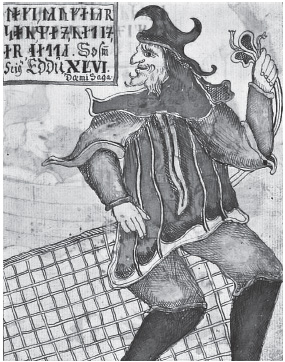
Fig. 49. Loki
It is Loki who kills Heimdallr. Scholars believe that Loki developed out of folk beliefs and was originally an evil spirit, goblin, or demon. In any case, he is a well-known character of Indo-European mythologies—the trickster—and Georges Dumézil has demonstrated that he has a counterpart in the Ossetian trickster figure Syrdon.
Many of Loki’s traits are simply epiphenomena: he is, first and foremost, the embodiment of evil; the wicked spirit that prevents the world from enjoying happiness; the troublemaker and the sower of strife. It is easy to see why neither place-names nor personal names show any trace of him.
For bringing about Baldr’s death, Loki receives a punishment that befits his malignant nature. The Æsir capture him and imprison him in a cave where they stand three flat stones on end and make a hole in each of them. They then fetch Loki’s sons Vali and Narfi and transform Vali into a wolf, who proceeds to tear his brother Narfi to pieces. The Æsir use Narfi’s guts to bind Loki to the three stones, set up in a way to cause as much pain as possible; these fetters then change to iron. Skaði sets a viper above Loki so that its venom will drip onto his face, but Loki’s wife, Sigyn, collects the poison in a cup. When the cup becomes full she empties it, and the venom that falls on Loki’s face at these moments causes him to writhe so terribly the world shakes. This goes on until Ragnarök.
 Dumézil, Loki; Jerold C. Frakes, “Loki’s Mythological Function in the Tripartite System,” Journal of English and Germanic Philology 86:4 (1987): 473–86; Tomoaki Mizuno, “Loki as a Terrible Stranger and a Sacred Visitor,” Studies in Humanities: Culture and Communication 30 (1996): 69–90.
Dumézil, Loki; Jerold C. Frakes, “Loki’s Mythological Function in the Tripartite System,” Journal of English and Germanic Philology 86:4 (1987): 473–86; Tomoaki Mizuno, “Loki as a Terrible Stranger and a Sacred Visitor,” Studies in Humanities: Culture and Communication 30 (1996): 69–90.
LOPTR: One of Loki’s names, which—like the Old Norse word lopt—means “air.” This name can be seen as reflective of Loki’s ungraspable and inconstant nature.
LORANDIN: In Seyfrid von Ardemont, a romance attributed to Albrecht von Scharfenberg (thirteenth century), this dwarf is one of the hero’s advisers. He warns Seyfrid about the strength of the dragon the hero must fight and offers him counsel. After the battle he loosens the knight’s helmet, brings him drink, and gives him roots with certain virtues to eat. When Seyfrid must contend with the giant Amphigulor, Lorandin gives him weapons and roots that increase his strength. After this battle he offers Seyfrid a magic ring set with gems that puts an end to the sufferings endured by five young women imprisoned by Amphigulor on behalf of a wizard. Lorandin finally provides the small band with five horses, alerts his people to the giant’s death, and henceforth regards himself as Seyfrid’s vassal.
LORELEI, LORELEY, LORE LEI, LURLEI: This nixie lives on a large rock, the Lurlenberg (mentioned as early as the thirteenth century), on the bank of the Rhine. She owes her existence to the 1802 novel by Clemens Brentano, Godwi oder Das steinerne Bild der Mutter (Godwi, or The Stone Statue of the Mother), but her popularity is due to the poem Heinrich Heine wrote about her in 1824. The Lorelei is sometimes a water fairy (Meerfei) with golden hair and sometimes a seductive demon, a magician who beguiles the minds of men. She was banished by a bishop and cast into the Rhine from atop the large rock that bears her name.
 Holbek and Piø, Fabeldyr og sagnfolk, 70; Petzold, Kleines Lexikon der Dämonen und Elementargeister, 124–25; Willy Krogmann, “Lorelei, Geburt einer Sage,” Rheinisch-westfälische Zeischrift für Volkskunde 3 (1956): 170–96.
Holbek and Piø, Fabeldyr og sagnfolk, 70; Petzold, Kleines Lexikon der Dämonen und Elementargeister, 124–25; Willy Krogmann, “Lorelei, Geburt einer Sage,” Rheinisch-westfälische Zeischrift für Volkskunde 3 (1956): 170–96.
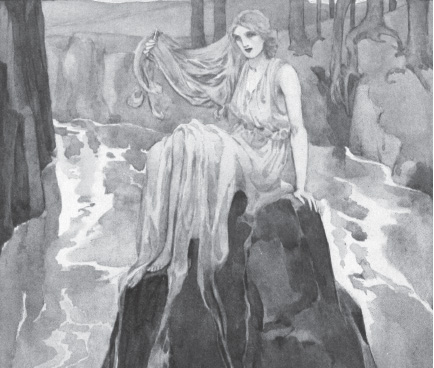
Fig. 50. Lorelei
LORG, ORG (masc.): A fantasy creature in Tyrolean legends that is described in various ways. It is sometimes a shapeless mass resembling a haystack, and it behaves like a perching spirit; sometimes it is a cubit in size and looks like a cat skin that moves by rolling. It could also be a large black man carrying his head under his arm, a one-eyed giant who comes out for the Twelve Days, or, lastly, a horseman dressed in a white mantle, who assumes gigantic size and terrifies all whom he meets.
 Alpenburg, Mythen und Sagen Tirols, 119–20; Zingerle, Sagen aus Tirol, 2–3, 124, 208–10.
Alpenburg, Mythen und Sagen Tirols, 119–20; Zingerle, Sagen aus Tirol, 2–3, 124, 208–10.
LUTCHEN (pl., “The Little Folk,” “The Wee Folk”): The Lutchen or Ludki were pagans and the first inhabitants of Lusatia. They are little individuals of both sexes, barely any taller than a foot, who wear red caps and jackets. They dwell in the dunes of the arid plateau, especially in the woods at the foot of the Koschenberg (Lower Lusatia). They maintain friendly relations with men, take part in their celebrations, and love to dance. They sometimes help people while they work and, in return, borrow their tools. When one of their race dies they incinerate his body and bury the ashes and remains in urns and weep copiously during the funeral. Together, the closest relatives hold small cups beneath their eyes to collect their tears, which are then placed around the urns.
 Lohre, Märkische Sagen, nos. 71–72.
Lohre, Märkische Sagen, nos. 71–72.
LYFJABERG (“Healing Mountain”): A mountain guarded by a giant where Menglöð lives. Any woman who climbs it will be cured, even if she suffers from disabilities or old age. The ill and wounded will find comfort there.
LYNGVI: A small island in Lake Amsvartnir. The Æsir lure the wolf Fenrir there and bind him. Fenrir will not break his chains until Ragnarök.